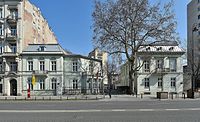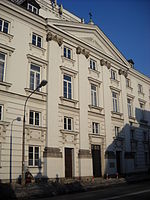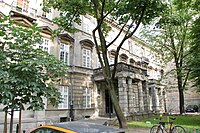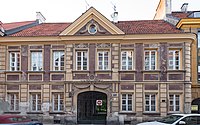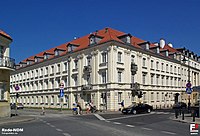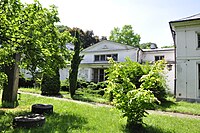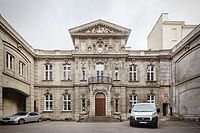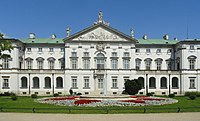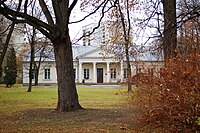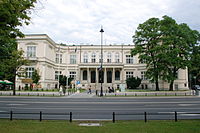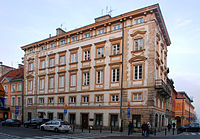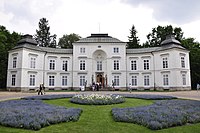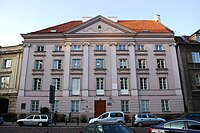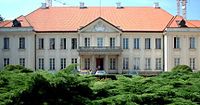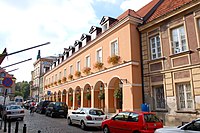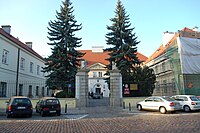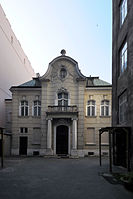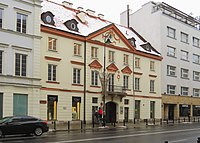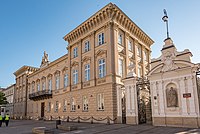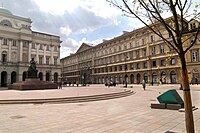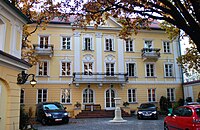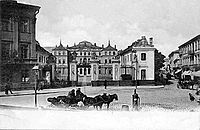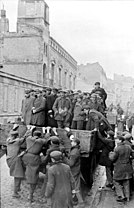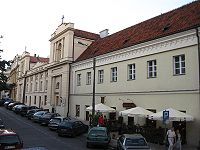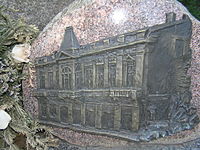List of palaces in Warsaw
History of palace construction in Warsaw


After it was decided in the second half of the 16th century with the Union of Lublin and the Articuli Henriciani that the Sejm should meet in Warsaw and that the election of the king should take place in a suburb of Warsaw, many of the powerful Polish magnate families began to hold residences for theirs to establish regular residence in the city. As Sigismund III. Wasa at the turn of the 17th century began - initially unofficially - to relocate the royal residence to Warsaw, where other noble families built palaces befitting their status. With the official designation as the capital of Poland in 1795, a third wave of expansion of the city with magnate residences finally followed.
In the history of the Warsaw palaces, often came over inheritance or sale in the hands of other families, so always diving members of the same old family Branicki , Chodkiewicz , Czartoryski , Czetwertyński , Denhoff , Krasinski , Koniecpolski , Leszczynski , Lubomirski , Ossoliński , Opaliński , Ostrogski , Pac , Poniatowski , Potocki , Prażmowski , Raczyński , Radziwiłł , Sapieha , Sanguszko , Sieniawski , Sobieski , Tyszkiewicz , Wielopolski or Zamoyski as builders or owners.
Architectural style
The palaces in Warsaw today mostly show a baroque or classicist architectural style. Mixed forms are rather rare, as the buildings that were rebuilt after the war were mostly built in a uniform state from the past. There are only a few buildings in the style or with echoes of Rococo , Historicism ( Neo-Renaissance , Eclecticism ) or Art Deco / Art Nouveau .
builder
In addition to Polish architects, Dutch and, above all, Saxon and Prussian builders played a decisive role in the construction of the Warsaw palaces in the 17th and 18th centuries. Various descendants of Italian immigrant families were influential in the 19th century. In the years 1946 to 1960, many Polish architects were employed in the context of the massive construction of war-torn objects.
17th century: Tylman van Gameren , Augustyn Locci , Isidoro Affaitati
18th century: Jakub Kubicki , Domenico Merlini , Giacomo Fontana , Simon Gottlieb Zug , Carl Friedrich Pöppelmann , Joachim Daniel von Jauch , Johann Sigmund Deybel von Hammerau , Ephraim Schröger , Friedrich Albert Lessel , Johann Heinrich Klemm , Johann Christian Kamsetzer , Chrystian Piotr Aigner , Johann Friedrich Knöbel , Andreas Schlüter , Johann Christoph von Naumann , Kacper Bażanka , Augustyn Wincenty Locci and Adolf Woliński
19th century: Antonio Corazzi , Borys von Zinserling, Adolf Gregor Franz Schuch , Władysław Marconi , Leandro Marconi , Jan Jakub Gay , Jan Kacper Heurich , Józef Huss , Francesco Maria Lanci , Enrico Marconi , Wilhelm Heinrich Minter , Witold Lanci , Andrzej Gołoński , Adolf Woliński , François Arveuf and Aleksander Jan Woyde
20th century: Bohdan Lachert , Zygmunt Stępiński , Piotr Biegański , Szymon Syrkus , Józef Szanajca , Elżbieta Kienitz-Trembicka, Maria Zachwatowicz , Jan Dąbrowski, Jan Bieńkowski, Marian Lalewicz , Bruno Zborowski, Zasław Malicki Stanisław Brukalski , Barbara Brukalska , Tadeusz Zieliński, Oskar Sosnowski, Lech Niemojewski and Mieczysław Kuźma .
location
The vast majority of the former Warsaw residences are located on the historical part of the Royal Wing (from the Royal Castle to the Belevedere Palace ) and on the streets Ulica Długa , Ulica Miodowa and Ulica Senatorska surrounding the old and new towns . Due to a lack of space, these palaces could not be built within the city walls of the old town; even in the new town there was only room for a few residences ( Chodkiewicz Palace , Mokronowski Palace, Sapieha Palace ). So most of the objects were created in the suburban area around the original city. The best location was on the high bank of the Vistula . Here - in line with the royal seats near the old town and in Jazdów ( Ujazdowski Castle ) - important families built their residences as early as the 17th century - such as the Kazanowskis or the Koniecpolskis ( presidential palace ). The parks of these palaces were located on the embankment sloping down towards the Vistula.
Palace complex
A typical feature of the Warsaw residences is the “French” structure of the ensemble: they are mostly symmetrical three-wing complexes with a set-back core structure ( corps de logis ), which is flanked by two side wings facing the street, thus forming the courtyard (cour d'honneur) . They are bordered on the street side by a grid with a gate in the central axis.
With a few exceptions ( Palace of the Bishops of Krakow ) , palaces in alignment with the street development were not built until the turn of the 19th century. Even if the residences from the 17th and 18th centuries were built in the Baroque style, they were mostly redesigned in a classicist or neo-renaissance style through renovations in the 19th century .
World War II and destruction
Almost all Warsaw palaces were destroyed in the Second World War. During the German attack on Warsaw in 1939, many objects in the inner city district were hit by bombs and most of them burned out. During the bitter fighting in the outlying districts during the Warsaw Uprising , palaces that were already damaged and still undamaged were also destroyed. The effort to finally destroy the city immediately following the suppression of the uprising eliminated building remains. Around 90% of the building fabric was lost. Only a few residences (mostly smaller objects) survived the destruction with only minor damage: the Belvedere, Dziewulski , Janasz , Karnicki , Koniecpolski , Natolin and Krasiński palaces . After the war, a majority of the destroyed palaces were rebuilt and mostly used as the seat of authorities. Since many palaces had been used as apartment buildings before the outbreak of war and had run down, older versions of the building history were largely chosen for the reconstruction. Old engravings and paintings were helpful here as models; works by Bernardo Bellotto (Canaletto) in particular were used to restore the baroque buildings.
reconstruction
Only in exceptional cases were palaces not built in an earlier original state. The successor building to the Rzyszczewski Palace was built on its foundations, but it is built in the neoclassical style, which the building never had. The Potocki Palace in Jabłonna never looked like it is today. The Jabłońowski Palace, which was only built between 1995 and 1997, has only one facade that corresponds to the old building, the entire structure at the rear is modern, functional architecture. The palaces Badeni , Gozdzki, Kotowski , Kronenberg , Lelewel , Walicki, Wierzbowski , Branicki as well as the Brühl and the Saxon Palais were not rebuilt . The reconstruction of some of these buildings is being discussed.
Lists
In the two following lists there are currently 94 existing and 26 former palaces. The list includes buildings in what is now Warsaw's urban area. Palaces in the Warsaw area (e.g. in Jabłonna ) are included in the list of castles, chateaus and palaces in the Masovian Voivodeship . Due to inconsistent linguistic regulation, those buildings are recorded that are referred to in German or Polish as palace (Polish: Pałac ), palais (Polish: Pałacyk ) or castle (Polish: Zamek ). In exceptional cases, this also includes lordly designed apartment buildings, provided they were used by the builder himself (such as the Gay Palace) or government offices (such as the palace of the Government Commission for Income and Finance ). As a rule, objects that were designed and built after the Second World War are not included (e.g. the Warsaw Palace of Culture or lavish private residences, exception: the palatial Russian embassy in the style of real socialist classicism). Buildings rebuilt after the war are included.
The year of completion is usually given as the construction date. Only known major modifications or extensions of the objects are recorded. This means that only a part of all the architects and builders involved in the redesigns to different style periods are named.
List of existing palaces in Warsaw
A.
| image | designation |
Alternative names |
location |
Coordinates |
Major years of construction |
Essential architects |
Major builders |
style |
Remarks |
|---|---|---|---|---|---|---|---|---|---|
| Abramowicz Palace | Downtown | 52 ° 14 '11 " N , 21 ° 1' 4" E | 1785 | Simon Gottlieb Zug | Grzegorz Abramowicz | classicism | |||
| Artichoke Palace | Marconi Palace | Downtown | 52 ° 13 '32.7 " N , 21 ° 1' 26.3" E |
Antonio Corazzi , Leandro Marconi |
Jan Sokołowski, Henryk Marconi (d. J.) |
Eclecticism with neo-Gothic elements | Headquarters of the Lithuanian Embassy in Poland |
B.
C.
| image | designation |
Alternative names |
location |
Coordinates |
Major years of construction |
Essential architects |
Major builders |
style |
Remarks |
|---|---|---|---|---|---|---|---|---|---|
| Chodkiewicz Palace | Downtown | 52 ° 14 ′ 50 " N , 21 ° 0 ′ 33" E | 1757, 1949 |
Józef Fontana, Stanisław Kostka Hoffman, Jan Bogusławski, J. Łowiński, Henryk Grunwald |
Cyprian Paweł Brzostowski, Jan Karol Wandalin Mniszech, Aleksander Chodkiewicz |
Rococo / Classicism | Today used as an office building by companies and institutions | ||
| Chodkiewicz Palace | Brzeziński Palace | Downtown | 52 ° 15 ′ 13.8 " N , 21 ° 0 ′ 28.5" E | 1776, 1950 |
Simon Gottlieb Zug , Czesław Bogusz |
Teofil Dunin – Brzeziński | classicism | Small palace in Warsaw's New Town | |
| Czapski Palace | Krasiński Palace, Raczyński Palace |
Downtown | 52 ° 14 ′ 22 " N , 21 ° 0 ′ 54.1" E | 1680, 1705, 1721, 1790, 1852, 1959 |
Tylman van Gameren , Augustyn Wincenty Locci , Carlo Bay , Kacper Bażanka , Johann Christian Kamsetzer , Enrico Marconi , Stanisław Brukalski |
Michał Kazimierz Radziwiłł, Michael Stephan Radziejowski , Adam Mikołaj Sieniawski , Stanisław Małachowski , Academy of Fine Arts |
Late baroque |
D.
| image | designation |
Alternative names |
location |
Coordinates |
Major years of construction |
Essential architects |
Major builders |
style |
Remarks |
|---|---|---|---|---|---|---|---|---|---|
| Dembiński Palace | Downtown | 52 ° 14 ′ 42.8 " N , 21 ° 0 ′ 39.3" E | 1st half of the 18th century, 1950 |
Urszula Morsztyn | classicism | Today the seat of the Polish Ministry of Sports and Tourism | |||
| Dom Pod Królami | Downtown | 52 ° 14 '43.4 " N , 21 ° 0' 27.2" E | 1621, 1747, 1962 |
Mikołaj Daniłowicz, Andrzej Stanisław Załuski , |
Baroque | Today the seat of the copyright organization ZAiKS | |||
| Działyński Palace | Downtown | 52 ° 14 ′ 39.3 " N , 20 ° 59 ′ 51.7" E | 1730s, 1760s, 1952 |
Johann Deybel von Hammerau , Chrystian Piotr Aigner |
Wincenty Potocki, Stanisław Kostka Potocki , Ignacy Działyński |
Early classicism | The palace is now used as an office building | ||
| Dziekana Palace | Dean's Palace | Downtown | 52 ° 12 ′ 58 " N , 21 ° 2 ′ 11" E | 1610, 1968 |
Stanislaw Marzyński | J. Raciborski | classicism | Property of the Archdiocese, intended as a museum | |
| Dziewulski Palace | Downtown | 52 ° 13 '30 " N , 21 ° 1' 23" E | 1910 | Wladyslaw Marconi | Stefan Dziewulski | Neo-renaissance | Acquired after the Second World War for the diplomatic mission of Bulgaria |
E.
| image | designation |
Alternative names |
location |
Coordinates |
Major years of construction |
Essential architects |
Major builders |
style |
Remarks |
|---|---|---|---|---|---|---|---|---|---|
| Ermitaz Palace | Downtown | 52 ° 13 '3.9 " N , 21 ° 2' 10.5" E | 1690, 1778 |
Tylman van Gameren , Dominik Merlini |
Stanisław Herakliusz Lubomirski, Stanislaus II August |
classicism | Object in Łazienki Park |
F.
| image | designation |
Alternative names |
location |
Coordinates |
Major years of construction |
Essential architects |
Major builders |
style |
Remarks |
|---|---|---|---|---|---|---|---|---|---|
| Palace of the Government Commission on Income and Finance | Downtown | 52 ° 14 '34.8 " N , 21 ° 0' 2.2" E | Middle of 17th century, 1825 |
Giovanni Battista Gisleni , Antonio Corazzi , Piotr Biegański |
Jan Leszczyński, State of Poland |
classicism | Today the seat of the mayor of Warsaw | ||
| Frascati Palace | White Palace, Branicki Lubomirski Palace |
Downtown | 52 ° 13 '44.3 " N , 21 ° 1' 43.1" E | 1779, beginning of the 19th century, 2nd half of the 19th century, 1948 |
Simon Gottlieb Zug , Leander Marconi , Zbigniew Karpiński, Tadeusz Zieliński |
Simon Chovot, Róża Potocka-Branicka |
classicism | Today museum |
H
| image | designation |
Alternative names |
location |
Coordinates |
Construction year |
Architects |
Builders |
style |
Remarks |
|---|---|---|---|---|---|---|---|---|---|
| Henryk Palace | Fanshawe Palace | Mokotów | 52 ° 11 ′ 41 ″ N , 21 ° 1 ′ 30 ″ E | 1850, 1952 |
Enrico Marconi | George Fanshawe | classicism | The renovated property is now used by a cosmetics company | |
| Hołowczyc Palace | Citizen's Palace | Downtown | 52 ° 14 '1.6 " N , 21 ° 1' 7.8" E | 1820, 1949 |
Antonio Corazzi | Karol Burger, Szczepan Hołowczyc |
classicism | The property is on Nowy Świat, where the famous E. Blikle café is located | |
| Humanski Palace | Downtown | 52 ° 14 '55.7 " N , 21 ° 0' 23.6" E | 1st half of the 18th century, 1735, 1754, 1837, 1963 |
Stanisław Zawadzki , Antonio Corazzi |
Jan Humański, piarists |
classicism | First school building of the neighboring Collegium Nobilium |
J
| image | designation |
Alternative names |
location |
Coordinates |
Construction year |
Architects |
Builders |
style |
Remarks |
|---|---|---|---|---|---|---|---|---|---|
| Jabłonowski Palace | Downtown | 52 ° 14 ′ 41 ″ N , 21 ° 0 ′ 35 ″ E | 1785, 1819, 1869, 1939, 1997 |
Giacomo Fontana , Domenico Merlini , Friedrich Albert Lessel , Józef Grzegorz Lessel , Rafał Krajewski, Józef Orłowski, Oskar Sosnowski |
Anton Jabłonowski, Warsaw City Council, BRE Bank |
Neo-renaissance | Today a modern office building behind a historic front facade | ||
| Palace of the Warsaw Hunters Society | Palace of the Club of the Warsaw Society of Hunters | Downtown | 52 ° 14 ′ 15 ″ N , 21 ° 0 ′ 38 ″ E | 1898, 1950 |
François Arveuf, Michał Ptic-Borkowski |
Warsaw Hunting Club , Society of Polish-Soviet Friendship |
historicism | Today the seat of the Polish Army Artistic Ensemble | |
| Janasz Palace | Czacki Palace | Downtown | 52 ° 14 ' N , 21 ° 0' E | 1875 | Jan Kacper Heurich | Jakub Janusz | Neo-renaissance | One of the few palaces that were not completely destroyed in the war |
K
L.
| image | designation |
Alternative names |
location |
Coordinates |
Major years of construction |
Essential architects |
Major builders |
style |
Remarks |
|---|---|---|---|---|---|---|---|---|---|
| Łazienki Palace | Palace on the water, palace on the island |
Downtown | 52 ° 12 '53 " N , 21 ° 2' 8" E | 17th century, 1795, |
Tylman van Gameren , Domenico Merlini |
Stanisław Herakliusz Lubomirski, Stanislaus II August |
classicism | Object in Łazienki Park | |
| Lesser Palace | Rembieliński Palace | Downtown | 52 ° 13 '27.5 " N , 21 ° 1' 28.8" E | Ender 1840s, 1949 |
Francesco Maria Lanci , Eugeniusz Wierzbicki |
Stanisław Lesser, Aleksander Rembeliński, Władysław Kurtz, Izrael Poznański |
Neoclassicism | Today office building and seat of various institutions | |
| Leszczyński Palace (Warsaw) | Gawroński Palace | Downtown | 52 ° 13 '24.2 " N , 21 ° 1' 25.3" E | unknown | Marcin Weinfeld | Used as an embassy building for Yugoslavia and Serbia until the 2000s | |||
| Lubomirski Palace (Warsaw) | Downtown | 52 ° 14 '22.7 " N , 21 ° 0' 4.3" E | Beginning of the 18th century, 1760s, 1950 |
Giacomo Fontana , Jakub Hempel , Tadeusz Żurawski |
Johann Deybel von Hammerau , Aleksander Lubomirski |
classicism | In 1970 the palace was rotated 78 degrees, today the seat of the employers' association BCC |
M.
| image | designation |
Alternative names |
location |
Coordinates |
Major years of construction |
Essential architects |
Major builders |
style |
Remarks |
|---|---|---|---|---|---|---|---|---|---|
| Małachowski Palace | Downtown | 52 ° 14 '47.1 " N , 21 ° 0' 45.3" E | 1730s, 1750s, 1785, 1948 |
Giacomo Fontana , Simon Gottlieb Zug , Zygmunt Stępiński |
Józef Benedykt Loupia, Jan Małachowski |
Baroque | The seat of the board of the PTTK, which was founded in 1950, is currently located in the palace | ||
| Młodziejowski Palace | Bidziński Palace, Morsztyn Palace, Igelström Palace |
Downtown | 52 ° 14 '50.2 " N , 21 ° 0' 38.4" E | 1771, 1808, 1957 |
Giacomo Fontana , Friedrich Albert Lessel, Borys von Zinserling |
Stefan Bidziński, Andrzej Młodziejowski, Feliks Potocki |
Baroque | Refurbished to a rental and office building after privatization in the 2000s | |
| Mniszech Palace | Downtown | 52 ° 14 ′ 37 " N , 21 ° 0 ′ 13.5" E | 1720s, 1770s, 1960s |
Burkhard Christoph von Münnich , Pierre Ricaud de Tirregaille , Gustaw Landau-Gutenteger Adolf Gregor Franz Schuch , Mieczysław Kuźma |
Wandalin Mniszech, Friedrich Wilhelm Mosqua , Warszawska Resursa Kupiecka |
classicism | Today the seat of the Embassy of the Kingdom of Belgium | ||
| Mokronowski Palace | Jakub Fontana House | Downtown | 52 ° 15 ′ 13.2 " N , 21 ° 0 ′ 25" E | 1771 |
Giacomo Fontana , Friedrich Albert Lessel |
Giacomo Fontana | Late baroque | The name Mokronowski Palace is probably a misunderstanding | |
| Mostowski Palace | Muranów | 52 ° 14 ′ 45.3 " N , 20 ° 59 ′ 56.6" E | 1735, 1750, 1762, 1824, 1927, 1949 |
Johann Deybel von Hammerau , Antonio Corazzi , Aleksander Sygietyński, Zygmunt Stępiński , Mieczysław Kuźma |
Adam Poniński, Adam Brzostowski, Jan Hilzen, Tadeusz Mostowski, Government of Poland |
classicism | Today the Warsaw Police Headquarters are located here | ||
| Mostovsky Palace (Tarchomin) | Tarchomin | 52 ° 19 '8.1 " N , 20 ° 56" 19.8 " E | 1790s, 1825 |
Simon Gottlieb Zug , Henryk Ittar |
Tadeusz Mostowski | classicism | |||
| Myślewicki Palace | Downtown | 52 ° 12 ′ 55 " N , 21 ° 2 ′ 17" E | 1778 | Dominik Merlini | Stanislaus II August Poniatowski | Early classicism | Object in Łazienki Park |
O
| image | designation |
Alternative names |
location |
Coordinates |
Major years of construction |
Essential architects |
Major builders |
style |
Remarks |
|---|---|---|---|---|---|---|---|---|---|
| Ostrogski Palace | Downtown | 52 ° 14 '11.1 " N , 21 ° 1' 22.2" E | 2nd half 17th century |
Tylman van Gameren , Mieczysław Kuźma |
Jan Gniński | Baroque | Today it houses the Chopin Society and the Chopin Museum |
P
| image | designation |
Alternative names |
location |
Coordinates |
Major years of construction |
Essential architects |
Major builders |
style |
Remarks |
|---|---|---|---|---|---|---|---|---|---|
| Pac Palace | Radziwiłł Palace | Downtown | 52 ° 14 ′ 49 " N , 21 ° 0 ′ 29.4" E | 1697, 1757, 1828 |
Tylman van Gameren , Giacomo Fontana , Enrico Marconi , Stefan Baliński, Oskar Sosnowski, Henryk Białobrzeski, Czesław Konopka |
Dominik Mikołaj Radziwiłł, Andrzej Stanisław Załuski , Ludwik Pac, |
classicism | Currently used by the Ministry of Health | |
| Potkański Palace | Pałac na Podkańskiem | Downtown | 52 ° 14 ′ 47.4 " N , 21 ° 0 ′ 13.6" E | 1771-1773 |
Dominik Merlini , Stefan Szyller |
Długa 44, today the Warsaw University building | |||
| Potocki Palace (Natolin) | Palace in Natolin | Ursynów | 52 ° 8 ′ 20 " N , 21 ° 4 ′ 25" E | 1784, 1807 |
Simon Gottlieb Zug , Chrystian Piotr Aigner |
August Czartoryski , Stanisław Kostka Potocki |
classicism | Today the seat of the College of Europe | |
| Potocki Palace (Warsaw) | Downtown | 52 ° 14 ′ 33 " N , 21 ° 0 ′ 49.5" E | 1690s, 1762, 1765, 1790s, 1881, 1949 |
Józef Piola, Giacomo Fontana , Ephraim Schröger , Simon Gottlieb Zug , Johann Christian Kamsetzer , Leandro Marconi , Władysław Marconi , Zygmunt Stępiński , Jan Zachwatowicz |
Ernest Denhoff, August Aleksander Czartoryski , Izabella Lubomirska |
Baroque | Today the seat of the Ministry of Culture and National Heritage | ||
| Presidential palace | Koniecpolski Palace, Namiestnikowski Palace, Radziwiłł Palace, Lubomirski Palace |
Downtown | 52 ° 14 ′ 34 " N , 21 ° 0 ′ 57" E | 1643, 1820, 1856 |
Constantino Tencalla , Chrystian Piotr Aigner , Alfons Kropiwnicki, Antoni Brusche, Antoni Jawornicki |
Stanislaw Koniecpolski | classicism | Seat of the Polish President | |
| Prażmowski Palace | Leszczyński Palace, Rautenstrauch Palace, Dobrycz Palace, Pastorius Palace |
Downtown | 52 ° 14 ′ 49 " N , 21 ° 0 ′ 47" E | 1667, 1760s 1949 |
Giacomo Fontana , Zygmunt Stępiński |
Joachim Pastorius, family Leszczynski , family Dobrycz |
Late baroque | Today the seat of the Association of Polish Writers and the “Literatka” restaurant | |
| Primate Palace | Downtown | 52 ° 14 '43.3 " N , 21 ° 0' 44.4" E | Mid 17th century, 1673, 1691, 1759, 1770s, 1927 |
Józef Fontana, Tylman van Gameren , Jan Chrzciciel Ceroni, Ephraim Schröger , Simon Gottlieb Zug , Johann Christian Kamsetzer , Marian Lalewicz |
Wojciech Baranowski, Michał Prażmowski, Michał Radziejowski , Stanisław Szembek, Adam Ignacy Komorowski, Antoni Kazimierz Ostrowski |
classicism | Today the venue of the company ZPR SA (media and casino conglomerate) | ||
| Przebendowski Palace | Radziwiłł Palace | Downtown | 52 ° 14 ′ 43.4 " N , 21 ° 0 ′ 15.4" E | 1st half of the 18th century, 1949 |
Simon Gottlieb Zug , Bruno Zborowski |
Jan Jerzy Przebendowski | Baroque | Today the seat of the Independence Museum | |
| Przeździecki Palace (Foksal) | Palace of the Polish Foreign Ministry | Downtown | 52 ° 14 '4.7 " N , 21 ° 1' 23.2" E | 1879, 1892, 1953 |
Marceli Berent, Józef Huss , Wojciech Onitsch, Marian Sulikowski |
Konstanty Przeździecki | Neoclassicism | The palace is used by the Ministry of Foreign Affairs | |
| Przeździecki Palace (Kościelnia) | Mostowski Palace, Mokrowski Palace |
Downtown | 52 ° 15 ′ 13 ″ N , 21 ° 0 ′ 27 ″ E | before 1734, 1762, 1806, |
Friedrich Albert Lessel , PRC architects |
Paweł Mostowski, Przeździecki family, Orco Group |
The palace is used today as the "Hotel Regina" |
R.
| image | designation |
Alternative names |
location |
Coordinates |
Major years of construction |
Essential architects |
Major builders |
style |
Remarks |
|---|---|---|---|---|---|---|---|---|---|
| Raczyński Palace | Downtown | 52 ° 15 ′ 0.4 " N , 21 ° 0 ′ 29.9" E | Early 18th century, 1786, 1950 |
Tylman van Gameren , Johann Christian Kamsetzer , Władysław Kowalski, Borys Zinserling |
Jakub Schulzendorf, Kazimierz Raczyński |
classicism | Today the main archive for old files is located here ( Archiwum Główne Akt Dawnych ) | ||
| Maria Lubomirska Radziwiłłowa Palace | Lubomirska Radziwiłłowa Palace, Lubomirski Palace, Dąbrowski Palace |
Downtown | 52 ° 14 '53.9 " N , 21 ° 0' 17.7" E | 1732, 1784, 1954 |
Anna Boye-Guerquin | Currently the seat of the Polish Art Institute of PAN (Instytut Sztuki PAN) | |||
| Villa Rau (Warsaw) | Downtown | 52 ° 13 '26.4 " N , 21 ° 1' 24.6" E | 1868, 1949 |
Leandro Marconi , Szymon Syrkus , Hans Schmidt |
Wilhelm Ellis Rau | Neo-renaissance | Today the seat of the Swiss embassy in Poland | ||
| Rusiecki Palace | Downtown | 52 ° 13 '18.9 " N , 21 ° 0' 42.8" E | 1914 | Józef Napoleon Czerwiński, Wacław Heppen |
Stanislaw Ursyn Rusiecki | Eclecticism | The property will be used by the Polska Akademia Umiejętności (PAU) in the future | ||
| Russian Embassy | Mokotów | 52 ° 12 '37.7 " N , 21 ° 1' 35.7" E | 1956 | Aleksandr Pietrowicz Wielikanow, Igor Jewgieniewicz Rożyn |
Soviet Union | Classicist Socialist Realism | Today the seat of the Russian embassy | ||
| Rzyszczewski Palace | Rzyszczewski villa | Downtown | 52 ° 13 '23.1 " N , 21 ° 1' 25.3" E | 1902 | François Arveuf | Count Rzyszczewski | historicism | The palace, which was destroyed in the war, was not rebuilt in the original style. The next building is the seat of the Hungarian embassy |
S.
| image | designation |
Alternative names |
location |
Coordinates |
Major years of construction |
Essential architects |
Major builders |
style |
Remarks |
|---|---|---|---|---|---|---|---|---|---|
| Sanguszko Palace | Jabłonowski Palace | Downtown | 52 ° 14 ′ 7 ″ N , 21 ° 1 ′ 5 ″ E | 1750, 1780, 1950 |
Zygmunt Stępiński | Adam Łodzia Poniński | Baroque | ||
| Sapieha Palace | Sapieha barracks | Downtown | 52 ° 15 ′ 15 ″ N , 21 ° 0 ′ 24 ″ E | 1734, 1746, |
Johann Deybel von Hammerau , Wilhelm Heinrich Minter , Maria Zachwatowicz |
Jan Fryderyk Sapieha | Baroque | ||
| Palace of the Treasurer | Wiśniowiecki Palace | Downtown | 52 ° 14 '33.2 " N , 21 ° 0' 6.3" E | 1830, 1954 |
Antonio Corazzi , Piotr Biegański |
Franciszek Ksawery Drucki-Lubecki , People's Council of the capital Warsaw |
Neo-renaissance | ||
| Sielce Palace | Stanisław August Bathhouse | Mokotów | 52 ° 12 '0.8 " N , 21 ° 2' 27.9" E | 1820 | Wilhelm Heinrich Minter | Konstantin Pavlovich Romanov | classicism | Today the palace is the seat of the employers' association PKPP Lewiatan | |
| Sierakowski Palace | Sierakowski barracks, Konwiktorska barracks |
Downtown | 52 ° 15 ′ 18.5 " N , 21 ° 0 ′ 17.5" E | End of the 18th century, 1820 |
Jakub Kubicki, Wilhelm Heinrich Minter , Barbara Andrzejewska |
Maksymilian Sierakowski | classicism | ||
| Sikorski Palace | Wola | 52 ° 13 ′ 40.4 " N , 20 ° 59 ′ 23" E | 1880 | Aleksander Sikorski | Neo-renaissance | ||||
| Sobański Palace | Downtown | 52 ° 13 '17 " N , 21 ° 1' 26.3" E | 1854, 1876, 1950 |
Julian Ankiewicz, Leander Marconi, Piotr Biegański |
Aniela Bławicka, Emilia Sobańska, Jan Wejchert |
classicism | Today the Polish Economic Council Club and a restaurant are located here | ||
| Staszic Palace | Downtown | 52 ° 14 '15 " N , 21 ° 1' 5" E | 1830, 1893, 1926, 1950 |
Antonio Corazzi , Michał Pokrowski, Marian Lalewicz , Piotr Biegański |
Warsaw Society of Friends of Science , Polska Akademia Nauk |
classicism | |||
| Stroński Palace | Stroński tenement house | Downtown | 1780s, 1948 |
Simon Gottlieb Zug , Jan Gierth, Franciszek Wołoski, Józef Zdzietowicki |
Andrzej Stroński, Stanisław Marzyński |
classicism | |||
| Symonowicz Palace | Downtown | 52 ° 13 '39.8 " N , 21 ° 2' 29.1" E | before 1762, 1951 |
Simon de Symonowicz, City District Library |
The scene of bitter fighting during the Warsaw Uprising . Today kindergarten | ||||
| Szaniawski Palace | Downtown | 52 ° 14 '49.1 " N , 21 ° 0' 39.3" E | 1st half of the 18th century, 1782, 1812, 1950 |
Stanisław Zawadzki , Friedrich Albert Lessel , Borys Zinserling |
Szaniawski family, Konstanty Felicjan Szaniawski, Tomasz Ostrowski |
classicism | |||
| Szlenkier Palace | Downtown | 52 ° 14 '13.9 " N , 21 ° 0' 35.8" E | 1883 | Witold Lanci | Karol Jan Szlenkier | Neo-renaissance | The palace is now the seat of the Italian embassy | ||
| Szuster Palace | Lubomirski Palace | Mokotów | 52 ° 12 '15 " N , 21 ° 1' 32.8" E | 1774, 1865, 1964 |
Ephraim Schröger , Simon Gottlieb Zug , Enrico Marconi , Adam Idźkowski, Jerzy Brabander |
Izabela Lubomirska, Anna Potocka |
historicism | The small palace now houses the Warsaw Music Society |
Ś
| image | designation |
Alternative names |
location |
Coordinates |
Major years of construction |
Essential architects |
Major builders |
style |
Remarks |
|---|---|---|---|---|---|---|---|---|---|
| Śleszyński Palace | Józef Fox Palace | Downtown | 52 ° 13 '25 " N , 21 ° 1' 25.3" E | 1826, 1948 |
Antonio Corazzi , Helena Syrkusowa , Szymon Syrkus |
Stanisław Śleszyński | classicism | Until 2010 the seat of the Representation of Serbia |
T
| image | designation |
Alternative names |
location |
Coordinates |
Major years of construction |
Essential architects |
Major builders |
style |
Remarks |
|---|---|---|---|---|---|---|---|---|---|
| Tyszkiewicz Palace | Tyszkiewicz – Potocki Palace | Downtown | 52 ° 14 '26 " N , 21 ° 1' 0.4" E | 1792, 1846, 1956 |
Johann Christian Kamsetzer , Enrico Marconi , Friedrich Albert Lessel , Jan Dąbrowski |
Ludwik Tyszkiewicz | classicism |
U
| image | designation |
Alternative names |
location |
Coordinates |
Major years of construction |
Essential architects |
Major builders |
style |
Remarks |
|---|---|---|---|---|---|---|---|---|---|
| Ujazdowski Castle | Downtown | 52 ° 13 '10 " N , 21 ° 2' 15" E | 1624, 1683, 1975 |
Matteo Castelli , Tylman van Gameren |
Sigismund II. August , Sigismund III. Wasa |
Early baroque | |||
| Uruski Palace | Czetwertyński Palace | Downtown | 52 ° 14 '24 " N , 21 ° 1' 1" E | 1847, 1895, 1951 |
Andrzej Gołoński , Józef Huss , Jan Dąbrowski |
Seweryn Urusky | Neo-renaissance | Today the seat of Warsaw University ( Institute for Geography and Regional Research ) |
V
| image | designation |
Alternative names |
location |
Coordinates |
Major year of construction |
Essential architects |
Major builders |
style |
Remarks |
|---|---|---|---|---|---|---|---|---|---|
| Palace to the Four Winds | Palace under the four winds, Tepper-Dückert-Palast |
Downtown | 52 ° 14 ′ 49.7 " N , 21 ° 0 ′ 14.6" E | 1680, 1951 |
Tylman van Gameren , Johann Deybel von Hammerau , Władysław Borawski |
Stanisław Kleinpolt, Piotr Tepper |
Baroque |
W.
| image | designation |
Alternative names |
location |
Coordinates |
Major years of construction |
Essential architects |
Major builders |
style |
Remarks |
|---|---|---|---|---|---|---|---|---|---|
| White House | White house, Biały Domek |
Downtown | 52 ° 12 '55 " N , 21 ° 1' 53" E | 1776 | Dominik Merlini | Stanislaus II August Poniatowski | Early classicism | The small palace was a royal guest house in the Royal Baths Park used | |
| Wessel Palace | Ostrowski Palace, Poczta Saska (Saxon Post), Stara Poczta (Old Post) |
Downtown | 52 ° 14 '37.1 " N , 21 ° 0' 49.6" E | Mid-18th century, 1882 |
Aleksander Jan Woyde , Władysław Marconi , Jan Bieńkowski |
Teodor Wessel, Antoni Kazimierz Ostrowski, Franciszek Ignacy Przebendowski |
Late baroque | The property served as a post office for a long time and is currently used by the Attorney General's office | |
| Eliza Wielopolska's palace | Downtown | 52 ° 13 '19.4 " N , 21 ° 1' 26.4" E | 1876 | Józef Huss | Antoni Nagórny, Eliza Wielopolska |
classicism | |||
| Wierzbicki Palace | Grochowski mansion | Praga Południe | 52 ° 14 '29.9 " N , 21 ° 6' 47" E | 1770s, 1818, 1927 |
Friedrich Albert Lessel , Zdisław Kalinowski Maksymilian Goldberg |
Michał Poniatowski Karl Osterloff Andrzej Wierzbicki |
Renaissance | The building in which General Józef Chłopicki allegedly resided during the Battle of Grochów now houses the Juliusz Zarębski State Music School | |
| Wilanów Palace | Wilanów | 52 ° 9 '54 " N , 21 ° 5' 22" E | 1679 | Augustyn Wincenty Locci | Johann III. Sobieski | Baroque | The palace at the end of the Warsaw Royal Route is known as the “Polish Versailles” | ||
| Wołowski Palace | Bourbon Palace, Palace of the Journalists |
Downtown | 52 ° 14 '2.5 " N , 21 ° 1' 24.2" E | 1878, 1951 |
Bronisław Brodzic Żochowski, Stefan Hołówski, Czesław Duchnowski, Jerzy Walerian Skolimowski |
Stanisław Wołowski, Maria Radziwiłłowa |
Neo-renaissance | Before the war, this was the seat of the Norwegian and US embassies |
Z
| image | designation |
Alternative names |
location |
Coordinates |
Major years of construction |
Essential architects |
Major builders |
style |
Remarks |
|---|---|---|---|---|---|---|---|---|---|
| Zamoyski Palace (Foksal) | Downtown | 52 ° 14 '4.1 " N , 21 ° 1' 26.3" E | 1879 | Leandro Marconi | Konstanty Zamoyski | Neo-renaissance | Today the seat of the architects' association SARP ( Stowarzyszenie Architektów Polskich SARP ) | ||
| Zamoyski Palace (Nowy Świat) | Downtown | 52 ° 14 '14.8 " N , 21 ° 1' 3.1" E | 1846 1950 |
Enrico Marconi , Adolf Woliński , Zygmunt Stępiński , Mieczysław Kuźma |
Andrzej Artur Zamoyski | Neo-renaissance | |||
| Sugar Factory Palace | Palace of the Association of Lublin Sugar Mills | Downtown | 52 ° 13 '16 " N , 21 ° 1' 5.5" E | 1910, 1922 |
Tadeusz Zieliński | Mieczysław Kaczyński, Association of Sugar Manufacturers |
Neo-Rococo | Today it houses the Adam Mickiewicz Institute |
List of former palaces in Warsaw
B.
| image | designation |
Alternative names |
location |
Coordinates |
Major years of construction |
Essential architects |
Major builders |
style |
Remarks |
|---|---|---|---|---|---|---|---|---|---|
| Bacciarelli Palace | Palace of Garden Friends of Warsaw | Downtown | 2nd half of the 19th century | Johann Christian Kamsetzer | Marcello Bacciarelli, Towarzystwo Ogrodnicze Warszawskie |
classicism | Former palace, not rebuilt after the Second World War | ||
| Badeni Palace | Downtown | 52 ° 14 ′ 56 " N , 21 ° 0 ′ 18" E | 1838 | Andrzej Gołoński | Ignacy Badeni | classicism | Former palace. Between the wars appellate court | ||
| Bloch palace | Downtown | 52 ° 14 '17.2 " N , 21 ° 0' 27.3" E | around 1730 | Bolesław Podczaszyński | JG Bloch | classicism | Former palace at 154 Marszałkowska Street | ||
| Great Branicki Palace (Nowy Świat) | Downtown | 52 ° 14 '15.8 " N , 21 ° 1' 2.9" E | Late 17th century, 1744, 1780, 1846 |
Simon Gottlieb Zug , Enrico Marconi |
Branicki family , Andrzej Artur Zamoyski |
historicism | Former palace, seat of the Ministry of Interior in the interwar period. Destroyed in the war and not rebuilt | ||
| Small Branicki Palace (Nowy Świat) | Downtown | 52 ° 14 '14.2 " N , 21 ° 1' 3.2" E | 1740s, 1780s |
Simon Gottlieb Zug , Enrico Marconi |
Branicki family , Andrzej Artur Zamoyski |
classicism | Former palace, used as a police headquarters ( Komenda Główna Policji Państwowej ) in the interwar period . Destroyed in the war and not rebuilt | ||
| Branicki Palace (Aleja Legionów) | Red palace | Downtown | 52 ° 13 '42 " N , 21 ° 1' 46" E | 1887 |
Leander Marconi , Alfons Gravier |
Branicki family | historicism | Former palace. Seat of the Romanian and later the French embassy. Destroyed in the war and not rebuilt | |
| Brühl's Palace | Ossoliński Palace | Downtown | 52 ° 14 ′ 31 ″ N , 21 ° 0 ′ 39 ″ E | 1642, 1696, 1759, 1788 |
Tylman van Gameren , Johann Friedrich Knöbel , Joachim Daniel von Jauch |
Jerzy Ossoliński , Józef Karol Lubomirski, Heinrich von Brühl , Domenico Merlini |
Baroque | Former palace, seat of the Polish Ministry of Foreign Affairs |
D.
| image | designation |
Alternative names |
location |
Coordinates |
Major years of construction |
Essential architects |
Major builders |
style |
Remarks |
|---|---|---|---|---|---|---|---|---|---|
| Dillenius palace | Downtown | 52 ° 24 '38.5 " N , 20 ° 53' 57.2" E | before 1881 | Franciszek Brauman | Klara Dillenius (sister of Wilhelm Rau) | Former palace on Ulica Piusa XI 17 , the seat of the German embassy in the interwar period |
F.
| image | designation |
Alternative names |
location |
Coordinates |
Major years of construction |
Essential architects |
Major builders |
style |
Remarks |
|---|---|---|---|---|---|---|---|---|---|
| Fontane Palace | approximate location | Former palace on Ulica Bonifraterska 11/12 |
G
| image | designation |
Alternative names |
location |
Coordinates |
Major years of construction |
Essential architects |
Major builders |
style |
Remarks |
|---|---|---|---|---|---|---|---|---|---|
| Gay palace | Downtown | 52 ° 14 '11.7 " N , 20 ° 59' 57.1" E | 1838 | Jan Jakub Gay | Jan Jakub Gay | Former palace / tenement at 19 Grzybowska Street, which served as a shelter for the homeless during World War I and was destroyed in World War II. On the photo the already destroyed building behind a truck transporting Jews from the ghetto (May 1941) | |||
| Gozdzki Palace | Downtown | 52 ° 14 '16.2 " N , 21 ° 1' 13.6" E | 1780 | Simon Gottlieb Zug | Janusz Sanguszko, Karolina Gozdzka |
Burned down in 1788 |
K
| image | designation |
Alternative names |
location |
Coordinates |
Major years of construction |
Essential architects |
Major builders |
style |
Remarks |
|---|---|---|---|---|---|---|---|---|---|
| Karaś Palace | Downtown | 52 ° 14 '17.8 " N , 21 ° 1' 6.5" E | 1772 | Giacomo Fontana | Kazimierz Karaś, Władysław pigeon house |
Late baroque | Former palace, demolished in 1912 | ||
| Palace of Cardinal Vasa | Downtown | Former palace | |||||||
| Kazanowski Palace | Downtown | 52 ° 14 ′ 42 " N , 21 ° 0 ′ 54" E | 1630s, 1637 |
Constantino Tencalla , Giovanni Battista Gisleni , Helena Thekla Lubomirska |
Władysław IV. Wasa , Adam Kazanowski |
Renaissance | Destroyed in 1656, a Carmelite monastery (picture) was later built in its place | ||
| Lesser Polt Palace | Downtown | 52 ° 14 ′ 57 " N , 21 ° 0 ′ 24.5" E | circa 1685, 1696 |
Tylman van Gameren | Stanisław Kleinpoldt (Małopolski), Jan Zbąski |
Former palace at 12-14 ulica Długa | |||
| Kotowski Palace | Downtown | 52 ° 15 ′ 12 " N , 21 ° 0 ′ 33" E | 1864 | Tylman van Gameren |
Adam Kotowski , Marie de la Grange d'Arquien |
Former palace on Rybaki Street | |||
| Kronenberg Palace Warsaw | Downtown | 52 ° 14 ′ 22.2 " N , 21 ° 0 ′ 45.3" E | 1860s | Friedrich Hitzig | Leopold Stanisław Kronenberg | Former palace, now the Victoria Hotel is located here |
L.
| image | designation |
Alternative names |
location |
Coordinates |
Major years of construction |
Essential architects |
Major builders |
style |
Remarks |
|---|---|---|---|---|---|---|---|---|---|
| Lelewel Palace | Downtown | 52 ° 14 '54.6 " N , 21 ° 0' 22.3" E | 1755, 1851 |
Ephraim Schröger , Simon Gottlieb Zug |
Constance Lölhöffel von Löwensprung, Henryk Jarzewicz, Lesser family |
Rococo , neoclassicism | Former palace |
M.
| image | designation |
Alternative names |
location |
Coordinates |
Major years of construction |
Essential architects |
Major builders |
style |
Remarks |
|---|---|---|---|---|---|---|---|---|---|
| Michler Palace | Downtown | 52 ° 14 '5 " N , 20 ° 58' 14.6" O Fbl | End of the 19th century | Karol Michler | Art Nouveau | Fought over during the Warsaw Uprising , the scout anthem "Pałacyk Michla" was dedicated to the palace | |||
| Miączyńska Palace | Downtown | Dorota Miączyńska | Former palace in the new town |
S.
| image | designation |
Alternative names |
location |
Coordinates |
Major years of construction |
Essential architects |
Major builders |
style |
Remarks |
|---|---|---|---|---|---|---|---|---|---|
| Saxon Palace | Downtown | 52 ° 14 ′ 27.7 " N , 21 ° 0 ′ 41.2" E | 1664, 1724 |
Tylman van Gameren , Joachim Daniel von Jauch , Johann Christoph von Naumann , Wacław Ritschel, Adam Idzkowski |
Tobias Morsztyn, Jan Andrzej Morsztyn, August II. , Iwan Skwarzow |
Baroque | Former Wettiner from which today only the -Königsresidenz tomb of the unknown soldier is received | ||

|
Sobieski Palace | Palais Marymont | Marymont | 52 ° 16 ′ 29 " N , 20 ° 57 ′ 29" E | 1697 | Tylman van Gameren |
Johann III. Sobieski Marie Casimire Louise de la Grange d'Arquien |
Former palace of Queen Marie. The name Marymont originated from the French "Mont de Marie" (Marie's mountain) |
T
| image | designation |
Alternative names |
location |
Coordinates |
Major year of construction |
Essential architects |
Major builders |
style |
Remarks |
|---|---|---|---|---|---|---|---|---|---|
| Tarnowski Palace | Downtown | 52 ° 14 ′ 32 " N , 21 ° 0 ′ 58" E | 1655, 1763, 1892 |
Charles Pierre Coustou, Kazimierz Loewe |
Franciszek Andrault de Buy, Stanisław Lubomirski |
Baroque | The palace no longer exists. The Hotel Bristol was built in its place at the end of the 19th century |
W.
| image | designation |
Alternative names |
location |
Coordinates |
Major years of construction |
Essential architects |
Major builders |
style |
Remarks |
|---|---|---|---|---|---|---|---|---|---|
| Walicki Palace | Downtown | 52 ° 14 '35.4 " N , 21 ° 0' 11.7" E | 1809, 1852 |
Friedrich Albert Lessel | Józef Walicki | Former palace at Plac Bankowy 2/4 at the corner of Ulica Senatorska 44 | |||
| Wielopolski Palace | Downtown | 52 ° 14 '28.7 " N , 21 ° 0' 1.1" E | before 1779 | Stanisław Zawadzki (vmtl) | Hieronim Wielopolski | Former palace in Ulica Elektoralna 6 corner Ulica Orla 2 | |||
| Wierzbowski Palace | "Hôtel de Prusse", "Hotel Angielski" | Downtown | 52 ° 14 ′ 32.9 " N , 21 ° 0 ′ 41.1" E | 1660s, 1750s, 1797, 1803 |
Stefan Wierzbowski, Heinrich von Brühl , Just Schultz, Tomasz Gąsiorowski |
Baroque | Former palace, destroyed in the war. From 1797 to 1939 the "Hôtel de Prusse" was located here, later the "Hotel Angielski" |
See also
Web links
- Description of 69 palaces at Warszawa1939.pl (in Polish)
literature
- Julius A. Chroscicki, Andrzej Rottermund: Architectural Atlas of Warsaw. 1st edition. Arkady, Warsaw 1978, DNB 800459628 , p. 228.
- Małgorzata Danecka, Thorsten Hoppe: Discover Warsaw. Walking tours through the Polish capital. Trescher Verlag, Berlin 2008, ISBN 978-3-89794-116-8 , p. 109.
- Janusz Durko: Album Warszawski / Warsaw Album. The image of the city according to the collections in the Warsaw Historical Museum. German-Polish edition. Agencja Reklamowo-Wydawnicza A. Grzegorczyk, Warsaw 2000, ISBN 83-86902-73-6 .
- Tadeusz S. Jaroszewski: Palaces and Residences in Warsaw. Interpress Publishing House, Warsaw 1985, ISBN 83-223-2049-3 , p. 142.
- Grzegorz Piątek, Jarosław Trybuś: Warsaw. The thematic guide to Poland's capital. Kamil Markiewicz (translator). Schröder, Publishing House for Regional Culture, Diepholz 2009, ISBN 978-3-89728-070-0 .
- Janina Rukowska: Travel guide to Warsaw and surroundings. 3. Edition. Sport i Turystyka, Warsaw 1982, ISBN 83-217-2380-2 , p. 48 f.
- Reinhold Vetter: Warszawa / Warsaw in: Poland. History, art and landscape of an ancient European cultural nation . (DuMont art travel guide). 3. Edition. DuMont Buchverlag, Cologne 1991, ISBN 3-7701-2023-X , pp. 133-204.
- Mieczysław Wallis: Canaletto. Warsaw's painter. Państwowy Inst. Wydawniczy, Warsaw 1954, DNB 450739783 .

